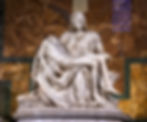Biography of Michelangelo
- Vincent Bardou
- Feb 9
- 3 min read
Painting of the portrait of Michelangelo (Michelangelo Buonarroti, in Italian), sculptor, painter, architect, poet and urban planner

Biography of Michelangelo (Michelangelo Buonarroti)
Introduction
Michelangelo Buonarroti (1475-1564) is one of the greatest artists of the Italian Renaissance. Painter, sculptor, architect and poet, he marked the history of art with his genius and lasting influence. His iconic works, such as the Sistine Chapel , the Pietà , David and the Last Judgement , have become symbols of artistic perfection and human expression.
1. Youth and Education (1475-1496)
Birth and Origins
Michelangelo di Lodovico Buonarroti Simoni was born on March 6, 1475 in Caprese , a small village in Tuscany, Italy. His father, Ludovico di Leonardo Buonarroti Simoni, was a magistrate, and his mother, Francesca di Neri del Miniato di Siena, died when he was only six years old.
Michelangelo showed an exceptional talent for drawing and sculpture at an early age. Against his father's wishes, he became an apprentice at the age of 13 in the studio of Domenico Ghirlandaio , one of the most renowned painters in Florence.
The Influence of Lorenzo de Medici
In 1489 he joined the Medici Academy in Florence, where he studied anatomy, sculpture and ancient works under the protection of Lorenzo de' Medici , one of the greatest patrons of the time. There he met influential intellectuals and artists who informed his style and artistic approach.
2. First masterpieces in Rome (1496-1504)
The Pietà (1498-1499)
In 1496, Michelangelo left for Rome, where he received a commission from Cardinal Jean de Bilhères: a sculpture of the Virgin holding the dead Christ . He created the Pietà , now on display in St. Peter's Basilica. This incredibly fine work is the only one he signed.
The David (1501-1504)
Back in Florence in 1501, he sculpted the David , a 5.17-metre statue depicting the biblical hero before his fight with Goliath. This marble sculpture became one of the greatest symbols of the Renaissance and is now on display at the Galleria dell'Accademia in Florence.
The Pietà is a marble sculpture by Michelangelo, located in St. Peter's Basilica in the Vatican, depicting the Virgin Mary holding the dead Christ.

3. The Sistine Chapel and the Apogee of its Art (1505-1534)
The Sistine Chapel (1508-1512)
In 1505, Pope Julius II commissioned Michelangelo to create his monumental tomb. But in 1508, he entrusted him with an even greater mission: to paint the vault of the Sistine Chapel in the Vatican.
Over the course of four years , Michelangelo alone completed this gigantic fresco of 520 m² , depicting biblical scenes such as The Creation of Adam , one of the most famous images in the history of art. This masterpiece revolutionized painting and influenced generations of artists.
The Last Judgment (1536-1541)
In 1536, under Pope Paul III , Michelangelo painted The Last Judgment , a monumental fresco on the altar wall of the Sistine Chapel. This dramatic work illustrates the end of time with unparalleled power and realism.

4. Final Years and Legacy (1534-1564)
Architecture and Poetry
In the last decades of his life, Michelangelo devoted himself more to architecture . In 1546 he was appointed chief architect of St. Peter's Basilica in Rome and redesigned the dome, which would later influence Renaissance and Baroque architects.
He also wrote numerous poems , often of spiritual and philosophical inspiration.
Death and Influence
Michelangelo died on February 18, 1564 , at the age of 88 , in Rome. His body was transferred to Florence and buried in the Basilica di Santa Croce .
His influence on art is immense. His revolutionary techniques in sculpture and painting, his concern for anatomical realism and his creative genius make him one of the most important artists in history.

5. Major Works of Michelangelo
Sculptures
The Pietà (1498-1499) – St. Peter’s Basilica, Rome
David (1501-1504) – Galleria dell'Accademia, Florence
Moses (1513-1515) – Basilica of Saint Peter in Chains, Rome
Slaves (The Dying Slave and The Rebel Slave) (1513-1516) – Louvre, Paris
Paintings and Frescoes
The Vault of the Sistine Chapel (1508-1512) – Vatican
The Last Judgment (1536-1541) – Sistine Chapel, Vatican
Architecture
Dome of St. Peter's Basilica (1546) – Vatican
Laurentian Library (1524) – Florence
Capitol Square – Rome
Michelangelo's David, an iconic Renaissance sculpture, depicts the biblical hero with an impressive mastery of human anatomy, on display in Florence.




